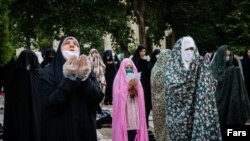Some Iranians including those who follow Supreme Leader Ali Khamenei's religious edicts marked the end of the fasting month with group prayers on Sunday, despite the coronavirus pandemic, while others who follow the edicts of other religious leaders hold Monday as the day of Eid al-Fitr.
The beginning and the end of the lunar month of Ramadhan, the ninth month in the Islamic lunar calendar, depend on sighting the crescent moon. Ramadhan lasts twenty-nine to thirty days, from one sighting of the crescent moon to the next, which takes 29 to 30 days. Fasting will continue on the 30th day if clouds make the sighting impossible on the 29th.
On Saturday evening, the official website of the Supreme Leader announced that based on sightings of the new moon crescent the Eid al-Fitr festival would fall on Sunday. Several other marjas or Grand ayatollahs regarded as sources of emulation by Shiites had declared Monday as the end of the month of Ramadan.
After Khamenei's announcement two high-ranking marjas – Ayatollah Naser Makarem Shirazi and Ayatollah Hossein Vahid Khorasani – changed their minds and followed Khamenei declaring Sunday as the day of Eid and said they were convinced the new moon was visible.
Eid al-Fitr prayers at Imam Ali Cadet School, Tehran, May 23, 2020.
Such discrepancies are not unprecedented. At least on one occasion in the past some marjas declared a different day than Khamenei did as the end of the fasting month.
The difference in verdicts depends on the conditions required by each ayatollah for "viewing the new moon". Some marjas require the crescent of the new moon to be seen with naked eye while others including Khamenei allow the use of instruments such as telescopes.
Some people saw a political aspect in the difference of opinion between Khamenei and other ayatollahs, but there is no evidence to say the sighting of the moon issue was an occasion to show defiance towards the ruler of the country.
Eid al-Fitr prayers on the street in Tehran on Sunday.
The official media announced the day designated by Khamenei as the end of the fasting month holiday. Iranians are free to choose who to follow as a source of emulation. They are, however, expected not to make a show of their separate Eid al-Fitr prayers if they celebrate the holiday on a different day, in order not to undermine Khameneni's supreme authority.
Khamenei who always leads the Eid al-Fitr prayers in Tehran himself and delivers a politically-charged sermon, has not had any public speeches since February when the first cases of coronavirus were reported in the country.
Eid al-Fitr prayers in Zahedan, Sistan and Baluchestan, May 23, 2020.
Last week health officials warned people to avoid traveling during Eid al-Fitr holidays to prevent a new surge of coronavirus infections but they allowed the prayers to be held if social-distancing rules were observed.
Photos from various cities in the country where prayers were held – mostly in open-air – show people wearing masks and keeping some distance. In Tehran the prayers were held at Tehran University and several other locations on Sunday.
Despite more than 2,000 new cases of COVID-19 each day, the coronavirus Combat Taskforce has also allowed shrines and mosques to open. Many are worried that the resumption of religious gatherings may reverse the relative success in the containment of the virus.
According to the latest official figures announced on Monday, the total number of cases of COVID-19 in Iran has risen to 137,724. With 34 more deaths on Sunday, the death toll now stands at 7,451.








